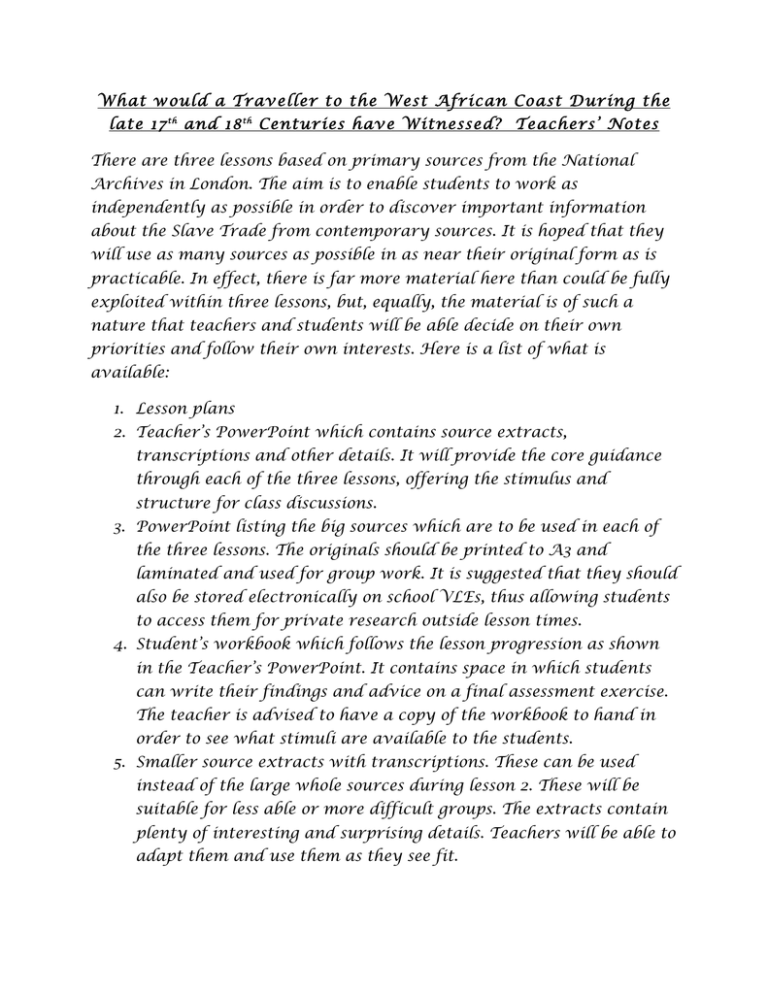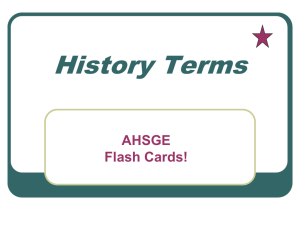What would a Traveller to the West African Coast During... late 17 and 18 Centuries have Witnessed? Teachers’ Notes
advertisement

What would a Traveller to the West African Coast During the late 17 th and 18 th Centuries have Witnessed? Teachers’ Notes There are three lessons based on primary sources from the National Archives in London. The aim is to enable students to work as independently as possible in order to discover important information about the Slave Trade from contemporary sources. It is hoped that they will use as many sources as possible in as near their original form as is practicable. In effect, there is far more material here than could be fully exploited within three lessons, but, equally, the material is of such a nature that teachers and students will be able decide on their own priorities and follow their own interests. Here is a list of what is available: 1. Lesson plans 2. Teacher’s PowerPoint which contains source extracts, transcriptions and other details. It will provide the core guidance through each of the three lessons, offering the stimulus and structure for class discussions. 3. PowerPoint listing the big sources which are to be used in each of the three lessons. The originals should be printed to A3 and laminated and used for group work. It is suggested that they should also be stored electronically on school VLEs, thus allowing students to access them for private research outside lesson times. 4. Student’s workbook which follows the lesson progression as shown in the Teacher’s PowerPoint. It contains space in which students can write their findings and advice on a final assessment exercise. The teacher is advised to have a copy of the workbook to hand in order to see what stimuli are available to the students. 5. Smaller source extracts with transcriptions. These can be used instead of the large whole sources during lesson 2. These will be suitable for less able or more difficult groups. The extracts contain plenty of interesting and surprising details. Teachers will be able to adapt them and use them as they see fit. Further Advice About Each Lesson Lesson 1 The idea for the first part of the lesson is to draw out as much knowledge about life in West Africa as possible just by using the pictures. They come from a book written by the Frenchman Jean Barbot at the end of the 17thC. You might be familiar with the Philosophy for Children style of learning – this activity is very akin to that. Essentially, every detail in the pictures is open for exploration or debate; nothing is disallowed; try to follow and yet also subtly steer the students’ lines of enquiry; think in terms of “What can we see?” And then “What can we infer from what we see?” Of particular interest are the canoes next to the ships – what role did canoes have in the local economy? Notice the fishing lines and nets. What skills must local people have possessed? What does the grouping of canoes imply – community collaboration, teamwork etc.. Try to build up a picture of local society and culture from within. Here is a copy of the first picture with some annotations to give you some idea of what may be discussed : European ships: what are they doing here? How do they compare with local vessels? Wildlife: what does it say about the environment? Nets and lines: what skills are evident? Canoes: how are they being used? What does this say about local technology, culture and society? Use the same techniques with the other two pictures. The last picture shows a fort. Students might speculate that this was designed to enable European conquest of Africa. They might think of William the Conqueror and imagine that the same is going on here. It will then be very interesting to show them the source which mentions trading with local canoes. Does this imply conquest? Perhaps not – more like co-operation. The students will be able further to explore the role of forts by looking at the plans and diagrams. Things to look out for include the representation of the fact that many European nations had bases and forts along the coast – how could they be empire building when they are all so close to each other? Other clues include the internal designs of the forts – they look as though they are for storage and imprisonment rather than for conquest. An important factual point for the teacher to bear in mind is that the forts’ primary purpose was the store the bullion and other goods such as cowrie shells which were exchanged for slaves. The imprisonment of slaves was a secondary purpose. Additionally, today, these forts are significant tourist attractions on the West African Coast. If you have time, you might like to discuss how this might affect people’s current understanding of the Transatlantic Slave Trade. Here are some interesting links: http://www.ship-wrecks.co.uk/GhanaSlaveForts.htm http://expass.wordpress.com/2011/02/13/west-africas-slave-forts/ http://www.douglashenderson.com/castles/index.htm http://continenttours.com/ghana/?gclid=COmjxJf0xKcCFQod4Qodj1gMC w It is also worth searching for modern sites on Google Earth. Lesson 2 This lesson contains risks: the students are being asked to engage in difficult work, but it is well worth doing. Young people do enjoy a mystery and a challenge; they love breaking codes and solving puzzles. With a bit of guidance, they should get a lot out of these materials. They should be told not to expect to be able to transcribe entire documents, but to pick out key details in order to acquire information about the mechanics of the slave trade. In any event, there are smaller, transcribed selections available for less able or less motivated students. Students will see instructions on where and how to acquire slaves, where to take them and how to sell them; they will see how the collecting of slaves was a protracted business which caused the sailors and the slaves to sicken and the ships to rot – notice the reference to making some repairs. There are also references to buying refreshments, tobacco and pipes for slaves. Is this evidence of humane treatment or something less selfless on the part of the captain and his crew? We finish with the famous image of the “Brookes” used by abolitionist campaigners in the 1790’s. It features in all the school text books and gives us our essential preconception of the slave trade. How accurate is it in view of the details we have just learned? For example, it implies that slaves were obtained at once and stowed en masse, whereas we learn from the sources that it took weeks to fill the ships with slaves. Lesson 3 Historians do not like dealing with psychological and emotional issues, but we are going to have a go. Again, we have derived our classic view of slave experiences from a few staple works, the main one being Olaudah Equiano’s autobiography which was published in 1789 (published as “Equiano’s Travels” by Heinemann in 1969 and currently available online). He was an abolitionist – his book was written as propaganda against the slave trade. Does it give us a true picture of slave experiences? It is worth trying to understand human experiences from the primary sources. There are examples of suicides and deaths possibly from extreme depression in the sources. These are well worth discussing and then juxtaposing with Equiano’s account. Hotseating is one way of developing empathy and imagination. Teachers will need to be sensitive about the roles which students choose to play and the composition of classes. Final Assessment At least one lesson or a considerable period of homework will be required at the end if students are to express their learning. Give as much freedom as possible whilst also trying to pin students down to producing a valid piece of work to a deadline. This is explained in the student workbook.



